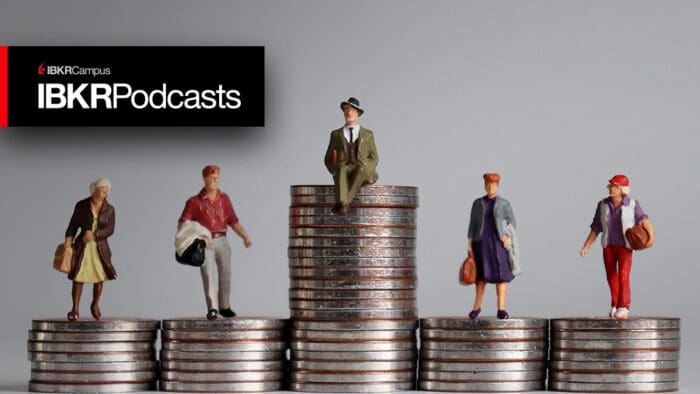Michael Normyle – Nasdaq’s US Economist joins IBKR’s Jeff Praissman to discuss consumer spending trends, and how the differ between the wealthy and lower income consumers.
Summary – IBKR Podcasts Ep. 170
The following is a summary of a live audio recording and may contain errors in spelling or grammar. Although IBKR has edited for clarity no material changes have been made.
Jeff Praissman
Hi everyone. It’s my pleasure to welcome back Michael Normyle, NASDAQ’s US economist, back to our IBR podcast studio. Michael, it’s great to see you again for a monthly podcast on the economy. How are you doing?
Michael Normyle
Doing well, thanks. Thanks for having me back. Glad to be back.
Jeff Praissman
In last month’s podcast, Big and Small: A Tale of Two Labor Markets, we discussed the diverging US labor markets between large and small companies.
Today I’d like to discuss another economic area with mixed results. Consumer spending. What trends are you seeing in consumer spending?
Michael Normyle
Well, so first off, I want to start by highlighting why consumer spending is so important. And that’s because it accounts for about 70% of US GDP.
So the health of consumers is hugely consequential to the health of the US economy overall. And so getting back to your question, though, lately we’ve seen increased signs of stress among lower-income consumers while higher income consumers are generally continuing to spend as normal.
Jeff Praissman
What are the biggest economic factors affecting the lower income consumers?
Michael Normyle
So it really starts with sticky inflation. Americans were able to keep spending through the period of really high inflation that we had peaking in in mid 2022 for a couple of reasons.
First, they were able to run down excess savings built up early in the pandemic and then eventually they saw real income gains as inflation slowed. But those factors are not supporting spending as much. So to explain a bit. Households built up about $2 trillion in what’s called excess savings, meaning savings above what would have been expected had the pandemic not happened, and that money was built up via stimulus checks, enhanced unemployment benefits, child tax credits, and then simply not being able to spend as much when you were stuck at home early in the pandemic.
And so those savings peaked in mid 2021. And they’ve been rundown since then. Just to kind of keep spending through that high inflation period. And the San Francisco Fed projects that they ran out early this year.
Then there’s the real income growth piece. And so that’s income after accounting for inflation and that was quite strong last year because of still strong nominal wage growth plus a record 8.7% Social Security cost of living adjustment.
And so in mid 2023, real income growth reached 5% year over year, but it’s been slowing since and now it’s just 1%.
So with those excess savings gone, many Americans have little cushion from other savings. In fact, there’s a Fed survey that shows that 37% of Americans say they couldn’t afford a surprise $400.00 expense with just cash or savings. And so adding that to slowing real income growth, then people have been increasingly relying on credit cards too.
Jeff Praissman
There’s always winners and losers, right, with the economy it seems. And sort of discussing here, it’s the lower income families that are really feeling the pinch. I Imagine that translates into certain industries that may be showing concern about what’s going on with lower income families versus other industries that may be doing well that maybe cater to higher income families that really they’re spending habits haven’t really been affected that much.
What sectors continue to benefit from the higher income consumers and then conversely, which ones are concerned about the current trend with the lower income families’ reduced ability to spend?
Michael Normyle
Yeah. So to your point, strength seems to be pretty broad based for those higher income consumers. So most industries are generally fine in that sense, but it’s particularly helping more recreational spending.
And then even for high income consumers, though, you do hear accounts of more budget minded big box retail stores talking about upticks in spending from those higher income consumers as they’re trying to strech their budgets still amid ongoing inflation.
But in contrast, for lower income consumers, you’re seeing emerging concerns from food and beverage brands, fast food restaurants and those big box retail stores. And so they’re expressing concerns where consumers are maybe trading down from name brands to store brands, opting to eat at home instead of dining out and then holding off on big ticket purchases.
Jeff Praissman
This next question, you’ve sort of touched on it just now with your past answer. As far as kind of where they’re moving your money. But I was going to ask you. Has the consumer behavior changed over the past year in what they’re choosing to spend their money on?
You know, it seems like the higher income are kind of going to those big box stores and the lower income are really just feeling the pinch and maybe not spending on any kind of extra items that they don’t really, truly need.
Michael Normyle
Yeah, I think the epicenter for this really has been durable goods. And so those are those big ticket items that I was just talking about. So thinking cars, appliances, furniture, those kinds of things and really that makes sense since these are often items that need to be financed and so higher rates make them more expensive.
Real durable goods spending rose 8% in 2023. This year it’s down 2% already and that puts it on track to fall nearly 6% if this trend continues. Within durable goods, the weakest categories have been autos and recreational goods and recreational vehicles.
Non-durable goods spending is down slightly this year. That’s things like clothing and energy and then services actually is holding up pretty well. So after rising 2.7% last year, it’s on pace to surpass that rate this year, but it’s mostly lifted by essentials like housing, utilities and healthcare.
So since services are 66% of all spending compared to just 13% of durable goods, total spending is still on pace to rise 1% this year, but that’s still just a third of last year’s pace actually.
Jeff Praissman
With the lower income consumers really feeling the pinch, I would assume that it’s having a ripple effect into their ability to save. And then also conversely, debt.
Is their credit card debt kind of spiraling upward and upward because of feeling the pinch on both ends of it?
Michael Normyle
Yeah, I think it’s particularly true, like you mentioned, for credit cards and I touched on that briefly earlier.
But to put some numbers to it, outstanding credit card debt is up over $300 billion since 2021, as people have had to rely on credit cards to finance spending more.
And so as a result, we’ve also seen delinquency rates for those credit cards rising too. And they’re actually the highest they’ve been since 2012 right now. One mitigating factor though, is that if you look at credit card debt as a share of disposable income, it’s actually only back to pre-COVID levels. So rising income has helped make that bigger debt pile somewhat more manageable.
Jeff Praissman
Now on the other side of that coin, the higher end consumers.
Have their investment decisions changed over the past year? Since they seem to have money to invest or have at least extra money. Whether or not they’re feeling any sort of pitch, they seem to potentially be able to take advantage of these higher interest rates or whatever else they’re looking to invest in.
Michael Normyle
Yeah. So higher rates have of course helped consumers in some way and on the flip side of the coin is that it’s made it costlier to borrow for everyone, whether high income or low income.
But on the positive side, people can get nearly risk-free interest rates of 5% plus from money markets and some savings accounts. On top of that, too, the equity market’s been doing well.
So as a result, the people with money to invest have been benefiting and that tends to be higher income families. Money market funds have seen over a trillion dollars in inflows in the last year to take advantage of those higher rates. And then we’ve seen Americans earn a record $3.7 trillion in annualized terms in Q1 from interest and dividends, and that’s about $800 billion higher than it was four years earlier.
So of course, like I said, this is mostly occurring to higher income households since they tend to have more assets in investments, but even for households in the bottom 40% by income, their assets are up about 30% since 2020.
Jeff Praissman
In the past and the rates were historical lows, it seemed everyone with the house was taking cash out the spend either by refinancing or taking out a home equity line of credit. Has that business dried up with these higher rates?
Michael Normyle
Yeah, exactly. You’ve seen a big drop in refinancing cash out or otherwise and same for home equity line of credits. But I think the interesting point here is that with home values increasing so much since the start of the pandemic, home equity is actually up $12 trillion in aggregate nationwide for the last four years.
So there’s a lot of equity that could be tapped if needed.
Jeff Praissman
What could cause a resurgence of people going back to pulling money from their house and boosting consumer spending?
Michael Normyle
Yeah, I think simply, it’s got to be rates is the biggest factor. So as the Fed starts cutting rates over the next couple of years, it could be an increasingly attractive option, especially if people can borrow against their house at a lower rate to consolidate things like higher interest credit card debt. But it’s all going to come down to rates and whether it makes sense.
Jeff Praissman
Got it. So that’s really the driving force whether or not people are going to use their equity in their homes to either pay down debt or invest in remodeling or other investments using that money.
Michael, this was great. Any final thoughts you’d like to leave the listeners with regarding these two diverging trends between high income and lower income consumers and their spending habits?
Michael Normyle
Like we started out the conversation saying, the consumer matters a lot to the economy. And the good news is that even though we’re definitely seeing some signs of stress from consumers, overall spending is still rising and should be helped by a combination of falling inflation, which could help boost real incomes. And then also by falling rates reducing the headwind to durable goods spending. So the consumer should keep supporting the economy. But just not at the strong pace we’ve seen in the last couple of years.
Jeff Praissman
Michael, thanks again. Love having you in the studio.
And for our listeners, thank you for tuning in. For more podcasts from Nasdaq, go to ibkr.com, click on Education and select Podcasts. Until next time, I’m Jeff Praissman.
Join The Conversation
If you have a general question, it may already be covered in our FAQs. If you have an account-specific question or concern, please reach out to Client Services.
Leave a Reply
Disclosure: Nasdaq
Index
Nasdaq® is a registered trademark of Nasdaq, Inc. The information contained above is provided for informational and educational purposes only, and nothing contained herein should be construed as investment advice, either on behalf of a particular security or an overall investment strategy. Neither Nasdaq, Inc. nor any of its affiliates makes any recommendation to buy or sell any security or any representation about the financial condition of any company. Statements regarding Nasdaq-listed companies or Nasdaq proprietary indexes are not guarantees of future performance. Actual results may differ materially from those expressed or implied. Past performance is not indicative of future results. Investors should undertake their own due diligence and carefully evaluate companies before investing. ADVICE FROM A SECURITIES PROFESSIONAL IS STRONGLY ADVISED.
© 2023. Nasdaq, Inc. All Rights Reserved.
Options
For the sake of simplicity, the examples included do not take into consideration commissions and other transaction fees, tax considerations, or margin requirements, which are factors that may significantly affect the economic consequences of a given strategy. An investor should review transaction costs, margin requirements and tax considerations with a broker and tax advisor before entering into any options strategy.
Options involve risk and are not suitable for everyone. Prior to buying or selling an option, a person must receive a copy of Characteristics and Risks of Standardized Options. Copies may be obtained from your broker, one of the exchanges or The Options Clearing Corporation, One North Wacker Drive, Suite 500, Chicago, IL 60606 or call 1-888-OPTIONS or visit www.888options.com.
Any strategies discussed, including examples using actual securities and price data, are strictly for illustrative and education purposes and are not to be construed as an endorsement, recommendation or solicitation to buy or sell securities.
© 2023. Nasdaq, Inc. All Rights Reserved.
Disclosure: Interactive Brokers
Information posted on IBKR Campus that is provided by third-parties does NOT constitute a recommendation that you should contract for the services of that third party. Third-party participants who contribute to IBKR Campus are independent of Interactive Brokers and Interactive Brokers does not make any representations or warranties concerning the services offered, their past or future performance, or the accuracy of the information provided by the third party. Past performance is no guarantee of future results.
This material is from Nasdaq and is being posted with its permission. The views expressed in this material are solely those of the author and/or Nasdaq and Interactive Brokers is not endorsing or recommending any investment or trading discussed in the material. This material is not and should not be construed as an offer to buy or sell any security. It should not be construed as research or investment advice or a recommendation to buy, sell or hold any security or commodity. This material does not and is not intended to take into account the particular financial conditions, investment objectives or requirements of individual customers. Before acting on this material, you should consider whether it is suitable for your particular circumstances and, as necessary, seek professional advice.



















I sopped reading this nonsense after the guest spoke about the ‘lower’ income cnsumer. To me he obviusly has no real contact nor experience with same. Although the ‘lwer’ may have rec’d from benefits during the pandemic, being what he is, he has no capabiliy, experience in savng anything. He operates under the common investment basis of ‘first in, right out.’ If you doubt my criticism then just go on to his next description of the ‘lower’s; status in that by latest poll, he cannot come up with $400. so how the hell did he get the former ability to save during the pandemic.